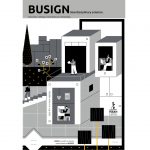

TFD (Tehran Furniture Design) Overview
The 32nd International Furniture Export Exhibition was held in Tehran for four days, from July 5th to July 8th.
Simultaneously with the International Exhibitions of Office and Home Furniture, the 3rd Tehran Furniture Design (TFD) event took place, consisting of two sections: Discourse and Design Competition. Over several days, this event featured panel discussions among designers, manufacturers, professors, and professionals in the field, leading to collaborations between the two groups.
On the third day of this event, a discourse focused on the intersection of business and design (BUSIGN) was held under the moderation of Mr. Majid Ahmadi Khoshbakht (CEO of MAKH Company and jury member of the Furniture Design Competition). The panel guests included Mr. Hedayat Sultan Mohammadi (founder and chairman of Farazin Company – an office furniture manufacturer), Mr. Hassan Masoud (CEO of Livetab Company – an office chair manufacturer), Mr. Kousha Darabnia (CEO of Arvinaj Company – an office furniture manufacturer), and Mr. Hamed Shahin Far (architect and interior designer, chairman of the board of Decoma Group).
The main focus of this discussion was on how to create a collaborative space between the business and design disciplines, the challenges and obstacles ahead, and ultimately presenting solutions to bring business and design closer together and foster mutual enhancement in the furniture industry.
The initial question was about the obstacles industry professionals face in establishing effective collaborations with designers. What issues cause cooperation and non-cooperation between business and design and what are the challenges facing them?
In response to this question, interesting perspectives were shared by the guests of this discussion. Mr. Sultan Mohammadi first addressed an important issue, which is the lack of a clear path for paying fees and royalties to designers. While this matter is more evident and established in the field of architecture and interior design, it has not been institutionalized in the furniture industry. Consequently, approaching designers from the perspective of industry professionals is not considered a natural or established practice.
Furthermore, Mr. Masoud spoke about his own experience of collaboration with designers, which had encountered failure. “Design is art, and industry is engineering! There is a gap between these two realms that need to be filled.” He went on to explain that design is an emotional and individual matter, while industry moves forward with logical thinking and is a collective and collaborative effort. It is up to both groups to move towards each other. However, the necessity of this collaboration is felt by businesses because successful production does not happen without design. Considering that the industry is business-oriented and economic interests are at stake, the presence of design and designers is inevitable. Industry professionals are the customers of designers, and therefore, it is the designers who should seek their clients, namely businesses. This alignment occurs through the formation of organizations and structures, perhaps in the form of design studios.

Mr. Darabnia, in agreement, added that companies have always had designers and emphasized that production without design is pointless for companies. Of Course, nowadays, the field of design has changed. As the furniture industry has progressed, designers have also made remarkable advancements. In the past, the workflow involved industry professionals using reverse engineering and copying. However, over time, designers have captured the attention of industry professionals with their innovative designs and propelled them toward creating new and original ideas. He then spoke of his experience collaborating with the design team at Arvinaj Company and the voids that were addressed through the designers spending time with the brand. With the knowledge gained from understanding the brand, designers were able to design products that delivered good performance for the company and its customers. Furthermore, he emphasized that both industry professionals and designers must desire to collaborate, as one-sided desire will not lead us anywhere.
Mr. ShahinFar addressed the issue that designers and industry professionals lack a common language and operate in different arenas. As long as these two individuals are not in harmony, one side always feels like the losing party. This lack of a common language leads the designer to present a design that they consider excellent from their perspective, but may not be feasible or producible from the industry professional’s point of view. While the industry professional needs to make modifications to the presented design to enhance its performance, the designer remains steadfast in their specific vision, resistant to any changes. The solution lies in the existence of designers who can approach matters from both a design and business perspective.

Continuing the discussion, Mr. Khoshbakht reminded everyone of an important point: that industry professionals still do not know how and when to utilize designers effectively. “As long as we see the design output as a product, we won’t get anywhere!” He further explained that design is a process and a culture that should encompass the entire supply chain. Each brand has different needs based on its identity, market requirements, and target audience. Designers must prioritize familiarizing themselves with the brand before initiating any work. Then, the question was raised: Does the industry fundamentally have the foundation for collaboration with designers? Has the industry established the necessary infrastructure for fostering such collaboration?
Mr. Darabnia, in response to this question, stated that the discussion of design in business is similar to sales strategies. Someone who examines sales also examines the market.“In my opinion, outsourcing to designers is meaningless because designers must live with the organization to design a product that meets the organization’s needs. Otherwise, this collaboration cannot be effective.“By living with the organization, what I mean is the designer spending time with the business.”This is when the business understands the designer’s initial needs and the designer becomes familiar with the business’s conditions and challenges. In this process, the designer and the industry professional reach a common framework that encompasses the interests of both parties. Collaboration between the industry professional and the designer should be like going to a psychologist, meaning it is not a one-time interaction but rather a process and a journey. Additionally, it was said that a designer cannot work with several similar brands because the policy of that designer is the same, and as a result, the products will have unwanted similarities.
Furthermore, some participants joined the discussion. In response to Mr. Darabnia’s viewpoints, Mr. Aslan Bigi (CEO of the Arvand brand) stated that considering each brand’s unique taste, it is the art of the designer to provide relevant and distinct designs based on the specific needs of each brand.
In the following, Mr. Shahin Far added that brands must have a distinct and specific identity and handwriting. Designs need to have a story, and it is even better if both the industry professional and the designer have reached that story together. Often, industry professionals expect their designers to identify the brand’s identity, which may not necessarily be accurate, as many aspects of the system are intuitive or subconscious. This issue can be addressed by brands having their brand book, which they can present to the designer before starting any projects. In addition to the brand book, brands must have a design book that clearly expresses the story, initial concept, and design standards. Without these, either effective communication between the designer and the industry professional will not form, or if such communication does take place, it will not be sustainable. In summary, it is important for the client (industry professional) to clearly and explicitly communicate to the designer what they want at the beginning of establishing collaboration.

In Conclusion, Mr. Khoshbakht added that as long as these infrastructures are not established within companies, any collaboration that takes shape will be temporary and fragile. Brands should, first of all, define their identity and provide designers with their brand book, including the brands’ DNA, Corporate Identity, organizational culture, target audience, organizational story, etc., along with the design book that encompasses macro and microelements, design standards, rules and limitations, visual elements, etc. This way, designers can work with similar brands without the concern that their designs will look alike. Each design is specifically created for each brand, taking into account its unique characteristics. It was further stated that the topic we are discussing today goes far beyond the appearance of a product. Nowadays, what is only physical and can be touched is not acceptable to the customers, we must create a new experience for the audience. Today, product quality is a requirement and the furniture industry must take a new direction and seek to create an experience for its customers.
In the end, the participants expressed their viewpoints, perspectives, and challenges, and the guests of the program responded to them accordingly.




